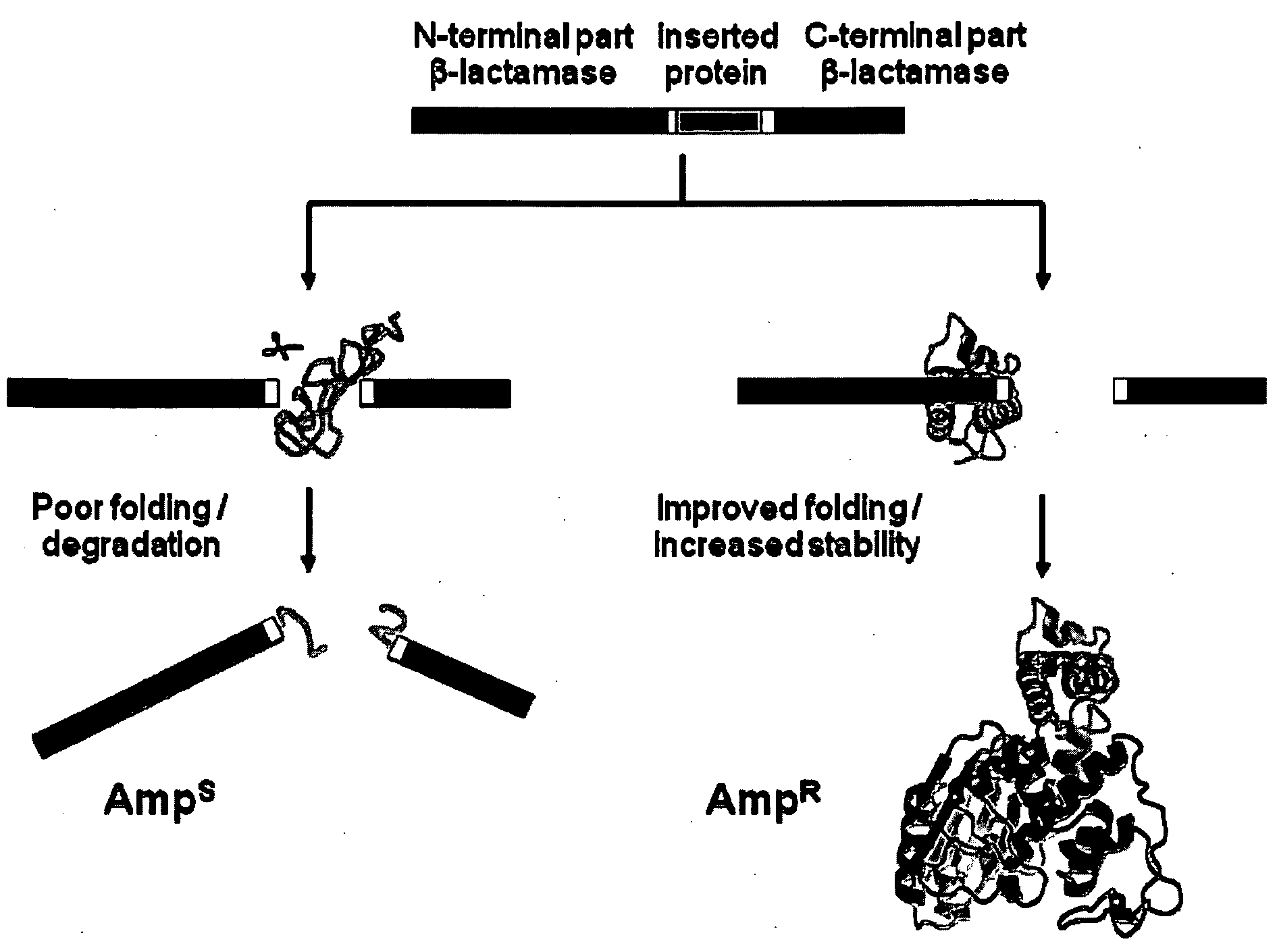Methods and compositions for increasing biological molecule stability
- Summary
- Abstract
- Description
- Claims
- Application Information
AI Technical Summary
Benefits of technology
Problems solved by technology
Method used
Image
Examples
example 1
[0145]This Example utilizes the properties of a tripartite fusion where the gene for the heterologous protein is inserted into a gene that encodes a screenable or selectable phenotype.
Materials and Methods
Plasmid Construction:
[0146]Escherichia coli strain NEB10beta was used for both cloning and expression purposes. For the expression of tripartite fusions between β-lactamase and Im7 or cytochrome b562, a flexible 30-amino-acid linker (GGGGS)2SSGSGSGSGS(GGGGS)2 (SEQ ID NO:1) was introduced between position 196 and 197 of TEM1-β-lactamase encoded by the vector pBR322. Recognition sites for PfoI and a Bsu36I in approximately the middle of the linker encoding region allowed the insertion of guest protein genes.
[0147]To eliminate a unique PfoI site within pBR322, the plasmid was linearized with PfoI and the resulting sticky ends filled in with Klenow enzyme. After phosphorylation the plasmid was recirculized by ligation, resulting in the derivative pBR322*. For the insertion of a linker ...
example 2
Kanamycin Based Screening
[0176]This example describes the development of a cytosolic selection marker, useful in both eukaryotic and bacterial species, based upon tripartite fusion. Several antibiotics are active against a variety of prokaryotic and eukaryotic hosts. Aminoglycoside phosphotransferase (3′)-IIa confers a selectable phenotype in both prokaryotic and eukaryotic cells. APH (3′)-IIa is a 29 kDa two domain protein. The Kanamycin binding pocket is present on the conserved C domain (FIG. 8). APH (3′)-IIa was present on high copy number plasmid pCR-blunt-II TOPO and expressed under its own promoter (FIG. 6). This plasmid was modified to inactivate the toxic ccdB gene by introducing a stop codon at position 5. Unique cleavage sites from pCR-blunt-II TOPO plasmid were removed by Nsi I digestion and relegation. The modified pCR-blunt-II TOPO vector was termed pTOPOccdB*.
[0177]Insertion site(s) in the APH (3′)-IIa protein were determined using the Tn7 GPS™-LS
[0178]Linker scanning...
example 3
Zeocin Screening System
[0183]This example describes a selection system based upon resistance to Zeocin, which kills a wide range of prokaryotic and eukaryotic hosts. The ShBle gene confers resistance against Zeocin and is present on the high copy number pCR-blunt II-TOPO plasmid (FIG. 6) and expressed under control of a constitutive bla promoter. The ShBle gene (372 bp) encodes a 13.8 kDa protein which captures Zeocin (FIG. 18). To screen potential insertion sites in the ShBle, pCR-blunt II-TOPO was modified and subjected to transposan mutagenesis with transprimer-4 as mentioned in example 2. Transposition in the ShBle gene or its promoter resulted in the loss of Zeocin resistance and gain of CmR. After transposition and transformation in NEB10 b cells, 800 ZeocinS colonies were collected. These zeocinS colonies were purified by 4 rounds of replica plating, which resulted in 500 pure zeocinS clones. All the ZeocinS clones were pooled and plasmid was extracted. PmeI digestion removed...
PUM
| Property | Measurement | Unit |
|---|---|---|
| Pressure | aaaaa | aaaaa |
| Electrical resistance | aaaaa | aaaaa |
| Interaction | aaaaa | aaaaa |
Abstract
Description
Claims
Application Information
 Login to View More
Login to View More - R&D
- Intellectual Property
- Life Sciences
- Materials
- Tech Scout
- Unparalleled Data Quality
- Higher Quality Content
- 60% Fewer Hallucinations
Browse by: Latest US Patents, China's latest patents, Technical Efficacy Thesaurus, Application Domain, Technology Topic, Popular Technical Reports.
© 2025 PatSnap. All rights reserved.Legal|Privacy policy|Modern Slavery Act Transparency Statement|Sitemap|About US| Contact US: help@patsnap.com



